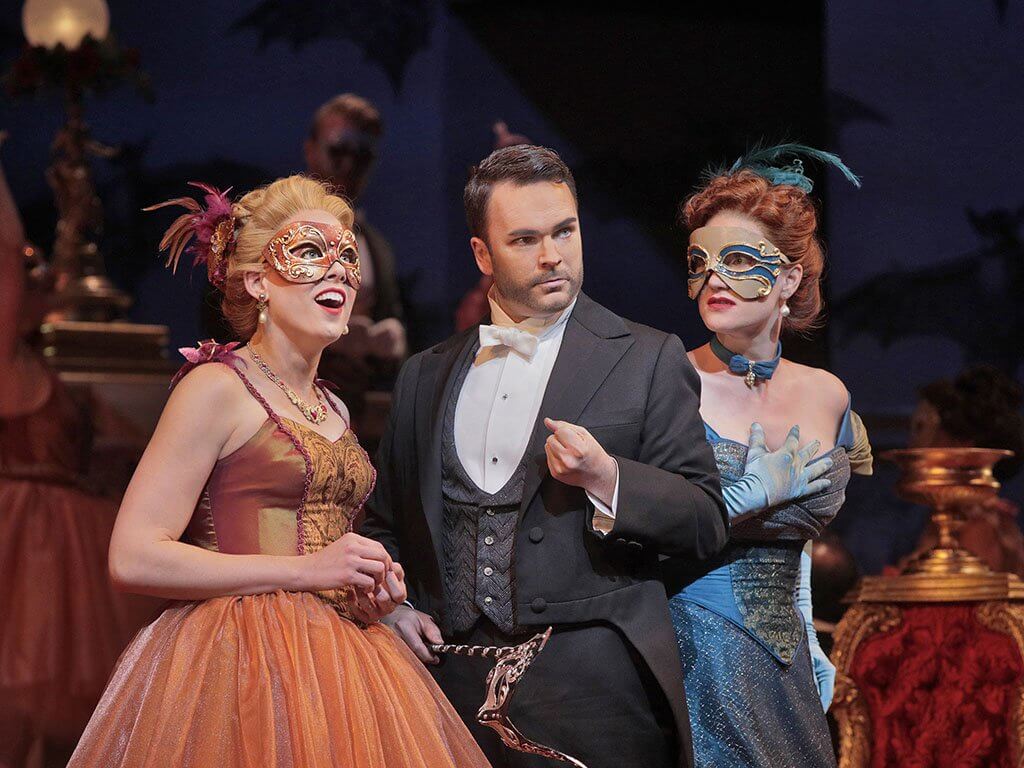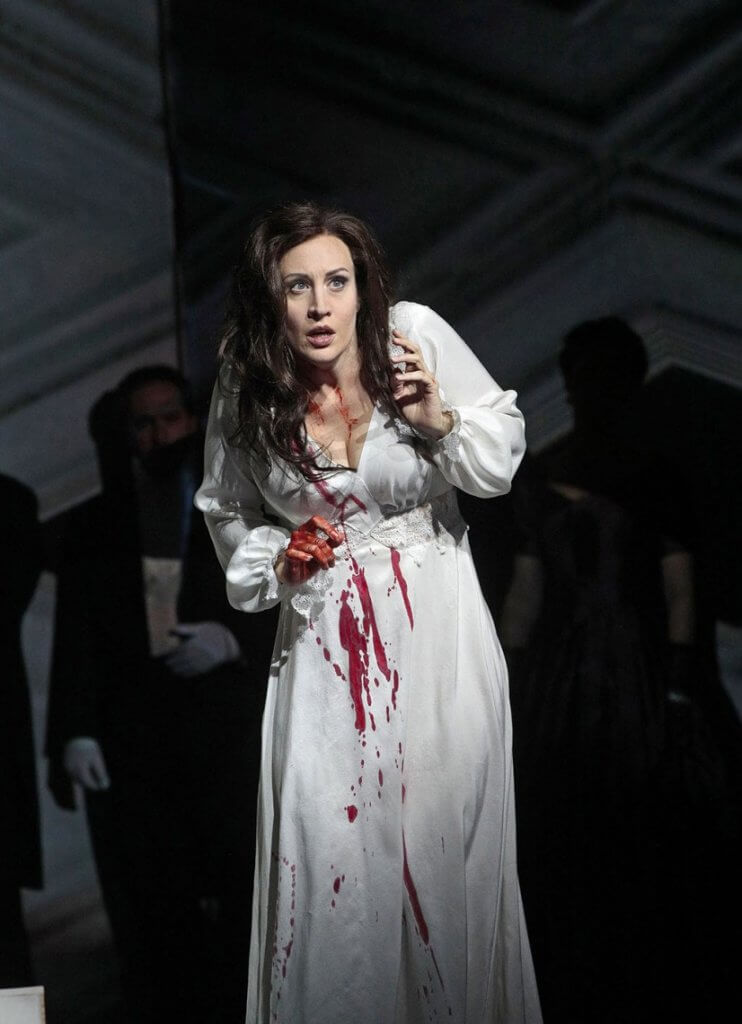
Donizetti: Lucia di Lammermoor. Brenda Rae, Mario Chang, Zachary Nelson, Christian Van Horn, Carlos Santelli. Corrado Rovaris, conductor. Ron Daniels, director. Santa Fe Opera. July 31, 2017.
Strauss: Die Fledermaus. Kurt Streit, Devon Guthrie, Jane Archibald, Dimitri Pittas, Joshua Hopkins. Nicholas Carter, conductor. Ned Canty, director. Santa Fe Opera. Aug. 1, 2017.
Since its inaugural season in July 1957, Santa Fe Opera has thrilled audiences with its annual summer opera festival. This year marks its sixtieth anniversary as one of a handful of summer opera festivals in the U.S.
It has been my destination of choice the last twenty years. Every time I visit, I’m struck by the magnificent outdoor theatre, with its spectacular view of the New Mexican landscape. And of course what’s on stage is pretty spectacular too. Journalists invariably come during the first week of August, also known as the “Press Week” when one can catch all five operas on consecutive evenings. It’s a time for us to renew acquaintances and meet new colleagues.
This year, the repertoire was vintage Santa Fe: something Baroque, the obligatory Italian warhorse, a comedy, a rarity, and a world premiere. The first two pieces I saw were two of my favourites—Lucia di Lammermoor and Die Fledermaus. According to the most recent statistics, Lucia is the 26th-most performed opera worldwide; Fledermaus is even more popular, coming in at No. 11. The Donizetti was last staged at SFO in 2001, while the Strauss hadn’t been seen there since 1992.
Typical of bel canto operas, Lucia di Lammermoor is all about voice, voice, and more voice. Santa Fe Opera has an exceptionally fine Lucia in American soprano Brenda Rae. I’ve heard her a number of times at the Bavarian State Opera, as a droll Olympia in Les contes d’Hoffmann and a scintillating Aminta in Die schweigsame Frau. Tall and willowy, Rae holds the stage well, combining dramatic acuity with a lyric coloratura of exceptional agility, with its full spectrum of tone colours. Her Mad Scene was arguably the best I’ve heard in a very long time, clear as a bell, all the way up to a high E-flat. Brava!
She was well partnered by Guatemalan tenor Mario Chang (Edgardo), who possesses a warm and pleasing lyric tenor, evenly produced. In Lucia, the tenor has the last word—or should I say, the last aria. When the Mad Scene is as good as the one by Rae, it’s a hard act for the tenor to follow! Kudos to Chang for singing “Tu che a Dio spiegasti l’ali” so well that it didn’t feel like an anticlimax. Christian Van Horn (Raimondo) impressed with his booming bass and physically imposing presence. Baritone Zachary Nelson was a dramatically vivid Enrico. Tenor Carlos Santelli, a voice new to me, was a fine Arturo.
Compared to the high musical values of this Lucia, the production itself, with set design by Riccardo Hernandez, came off as second-best. The simple set consisted of two large panels with projections of what appeared to be ceiling tiles of a grand Scottish mansion, austere but serviceable. Ron Daniel’s stage direction was also neutral and rather static, without a whole lot of action, with the soloists resorting basically to stand and sing. It’s de rigueur these days to portray the Lucia-Enrico relationship as incestuous, and this production was no exception. Conductor Corrado Rovaris, in a welcome return to SFO, led the orchestra in a crisp and incisive reading of the familiar score.

If their Lucia was on the minimalist side, SFO’s production of Die Fledermaus was traditional and elaborate, with costumes (supplied by Washington National Opera) to match. Stylistically it was decidedly more Broadway than Vienna, par for the course when it comes to SFO’s approach to Viennese operettas. It was entertaining, but the staging was just too busy, particularly in Act 2. Do we really need a lot of the action, i.e. an unending supply of dancers, to upstage the singers? While I’m not a fan of Viennese operettas sung in English, this translation by Ruth and Thomas Martin is actually quite funny, especially Orlofsky’s “Chacun à son goût.”
The spoken English dialogue was adapted by Charles Ludlam from W.S. Gilbert’s play On Bail. There was just a bit too much of it, especially with all the shenanigans in Act 3. The whole point of having English dialogue is to allow full comprehension by the non-German audience, and to introduce some local flavour. Surprisingly there isn’t a whole lot of topical reference, with one exception: a brilliant moment that brought the house down. In Act 3, Alfred, Rosalinda’s former lover, drolly acted and robustly sung by tenor Dimitri Pittas, is in jail due to mistaken identity. That doesn’t stop him from belting out snippets of Italian opera arias in his cell. Frosch the Jailer (an over-the-top Kevin Burdette) snickers: “Italiano?” Without missing a beat, Alfred quips: “Si, Scaramucci!” Well, you can imagine the collective roar from the audience!
Musically it was a fine performance, with good singing and spirited acting from all concerned. Eisenstein is normally a baritone role, but here taken by Albuquerque native and tenor Kurt Streit, who impressed with perfect comic timing. Devon Guthrie, a former SFO apprentice, was a youthful and fresh-voiced Rosalinda; her Csardas was well enough sung if somewhat small scale, without the in-your-face flamboyance one would have expected from this very prima donna moment. Canadian soprano Jane Archibald was a saucy Adele, her “Laughing Song” suitably sparkling. I had a chat with her the next day at the SFO Gift Shop where she and her husband Kurt Streit were signing autographs. She revealed that she’s saying farewell to the maid Adele with this run. In the future, expect her to move on to tackle the mistress of the house, Rosalinda!
Canadian Joshua Hopkins, a frequent SFO guest artist, was an excellent Dr. Falke, his smooth-as-silk lyric baritone shined in “Bruderlein, Schwesterlein” (in its English equivalent). Irish mezzo Paula Murrihy took over from Susan Graham as Orlofsky. An acting role, it didn’t really show off Murrihy’s fine lyric mezzo nearly as well as the following evening, when she sang a terrific Ruggiero in Alcina. Australian conductor Nicholas Carter made his American debut with this run, conducting the scintillating score with the requisite effervescence. All in all, a lovely start to my Santa Fe sojourn.
For more REVIEWS, click HERE.
Want more updates on Toronto-centric classical music news and reviews before anyone else finds out? Follow us on Facebook or Twitter for all the latest.
- SCRUTINY | Opera Atelier’s All Is Love Makes Triumphal Return - April 15, 2024
- SCRUTINY | From The Heart: Ema Nikolovska And Charles Richard-Hamelin Offer Unique Program At Koerner Hall - March 26, 2024
- SCRUTINY | The Glenn Gould School Spring Opera Presents A Superb Dialogues Des Carmélites - March 22, 2024



